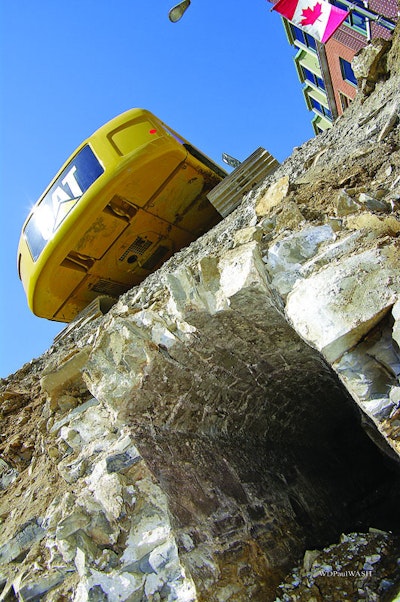
Interested in Cleaning?
Get Cleaning articles, news and videos right in your inbox! Sign up now.
Cleaning + Get AlertsKingston, Ontario, is a city of 125,000 offering a vibrant downtown core with historic buildings, an attractive waterfront and a booming hospitality industry. After completing a sewer and water main construction project that saw two blocks of the downtown core excavated from storefront to storefront in the summer of 2010, Utilities Kingston is moving forward on phase two with a strategy that balances the urgency for infrastructure renewal with the needs of stakeholders.
Kingston’s sewer and water system dates back as far as the 1800s. Water mains consist of materials including cast and ductile iron, concrete, PVC and HDPE. Sewer lines consist of concrete, clay, clay tile, PVC and HDPE. The main driver of the city’s official Pollution Prevention and Control Plan is the need to address combined sewer overflows into the Cataraqui River. The primary target is the replacement of a 3/4-mile length of combined sewer along Princess Street.
“The combined system is a gravity-fed box sewer about 4 1/2 feet wide and 3 1/2 feet high carved out of limestone bedrock,” says Jim Keech, president and CEO of Utilities Kingston. “It’s more than a century old and shows an amazing eye for craftsmanship. They were so conscientious, they built them with stone archways capped by keystones that nobody would ever see again until they were exposed.”
The city had also established a Downtown Action Plan designed to rejuvenate downtown streets, something that could be achieved on the back of the CSO project.
“We originally planned to do four to six blocks, then stay out of the way of downtown merchants and businesses for awhile,” says Keech. “That met with a pretty cold reception. Some of those businesses have experienced flooding as a result of the combined sewer system and support the project, but deep down they hope it’s something we can achieve by coming in at 10 o’clock some night, and complete by the following morning.”
Planning for success
The utility decided instead to work closely with stakeholders on an initial smaller project, then use the lessons learned to begin the next phase. The planning, consultation and environmental approvals required more than twice as much calendar time as the actual construction, notes Keech.
Stakeholder meetings began early in 2008. Local businesses were promised at least one year’s notice of road closures to help them prepare.
“We debated whether we would start at the top of the system or the bottom,” says Jim Miller, director of Utilities Engineering with Utilities Kingston. “We decided it made more sense to start at the bottom. A project such as this requires the ability to manage the commingled system until the project is finished. As you move upstream and install separate systems, you’re dealing with a smaller and smaller volume of combined sewer flow.”
The initial endeavor was dubbed the Big Dig and targeted two blocks of Princess Street from the shore of Lake Ontario up, with side construction on one adjacent street.
As an asset manager, Utilities Kingston holds responsibility for water, sewers, gas and electricity. Each of the services it offers would be upgraded, where necessary, during construction.
The utility fields an operations crew committed to maintenance and repair of sewer and water infrastructure. It owns a fleet of dump trucks and a few smaller excavators, and also operates a Vactor hydroexcavator and a sewer jetter by Super Products.
In-house crews conduct CCTV inspections of service laterals, stubs and short turns using a selection of push-and-track cameras by Pearpoint, housed in customized vans. A broader annual sewer inspection covering from 10 to 20 miles per year is conducted by outside contractors.
Limestone sewers resist CCTV
Efforts to inspect the limestone sewers with CCTV cameras failed to shed much light on their condition.
“The camera was bouncing along the rough surface of the limestone, getting caught and splashing through sewage,” says Miller. “We couldn’t learn much more about it without exposing it.”
Prior to excavation, the utility studied historic infrastructure maps and confirmed locations of city and customer infrastructure with ground-penetrating radar.
“We also performed our due diligence in terms of potential environmental and archaeological finds using test hole drilling,” says Keech. “On other projects we’ve discovered anything from contaminated soil to the remains of soldiers buried in unmarked graves. We let everyone know that if we found an oil slick from an old gas station or a stash of cannonballs, all scheduling bets were off.”
This was a unique project requiring both technical construction expertise and a major public relations component. It also required the contractor to devise a plan to provide consistent delivery and customer access for each business during the project. As a result, the project was issued under a Request for Proposal (RFP), with contractors aided by the utility’s engineering team.
“City Council approves our rates and budgets, but we can generally plan on a three- to four-year capital budget,” says Keech. “That allows us some freedom in purchasing decisions and issuing contracts.”
Area contractor Len Corcoran Excavating submitted the winning bid of $4 million.
Construction crews moved into the project zone on March 1, 2010.
Len Corcoran crews replaced the combined limestone sewer with 36-inch-diameter concrete storm pipe and a 12-inch PVC plastic pipe for sanitary.
“The 8-inch cast iron water line had an internal diameter of only 5 inches left, so we restored capacity by installing an 8-inch PVC pipe,” says Miller. “Since we knew the dimensions of the limestone trenches, we realized that they still held some value for us. We used them to place either the new sewer and storm lines or the water mains, depending on the system design in that location.”
As promised, the road was excavated from storefront to storefront. Special protected pathways were established, allowing customers and delivery vehicles to access any business on the street.
Working with the effort, Kingston’s downtown business improvement association launched a campaign inviting shoppers to see “the oldest limestone sewers on Earth.” They offered Big Dig pricing and wore T-shirts sporting Big Dig logos and sun visors identified as “sewer-visors.”
When an excavator accidentally ruptured a water line, the construction company liaison immediately visited local businesses, explaining what had happened, and how long it would take to restore service.
“Our office didn’t receive a single call about the disruption to water service,” Keech says.
Miller notes that the sewer and water work was straightforward — it was the communications, traffic management and logistics of the construction site that consumed most of the effort. The project wound down in July of that year.
Big Dig 2 builds on experience
Armed with the experience of the original Big Dig, Utilities Kingston is embarking on the second phase of the project in 2013, moving two blocks upstream and extending to two cross streets. Len Corcoran Excavating again won the bid at $6.2 million.
Initial project plans scheduled the work over two years, one block per year, beginning in the spring of 2013.
“The merchants told us that they wanted us out of the way on Princess Street by July 1, the beginning of the tourist season,” says Keech. “To accommodate them, we fast-tracked the project and moved up the construction date to February.”
Working in colder temperatures and spring rain required the contractor to erect tents and canopies over the construction site and provide heated water to local businesses, so that temporary supply lines wouldn’t freeze.
The new schedule, however, didn’t affect the contract price.
“The contract was tendered on a Request for Proposal basis with the price based on value engineering,” says Keech. “The dollar value of the work remains the same, even though the new schedule begins earlier. We’re planning to have Princess Street substantially completed by July, with work on the side streets continuing through the summer and finishing in 2014.”
Adam Metcalfe is the co-project manager for Len Corcoran, in charge of “out-of-the-fence” responsibilities, including the communications effort for Big Dig 2.
“We’ll be continuing with the personal approach,” he says. “Handbills only go so far. I want to talk to people face-to-face so I can share a laugh with them and gauge their reactions to what I’m saying. They also have individual questions that can best be answered in person.”
Metcalfe is looking for an office location in one of the buildings lining the street.
“We’re not using construction trailers that could block the site lines to a business across the street,” he says. “If we expect businesses and residents to put up with construction, we’d better be prepared to make some concessions, too.”
When work finishes up next year, Keech says he’ll already be drafting potential plans to complete the remaining five blocks of the Princess Street CSO project.
“All we’re saying at this point is that we’ll spread the work over more than five years, but fewer than 10,” he says. “Some stakeholders would like some time off, but I’d like to be a little more aggressive and bite off a bigger project. However, we need to balance what works best from an engineering standpoint against the concerns of the community.”









